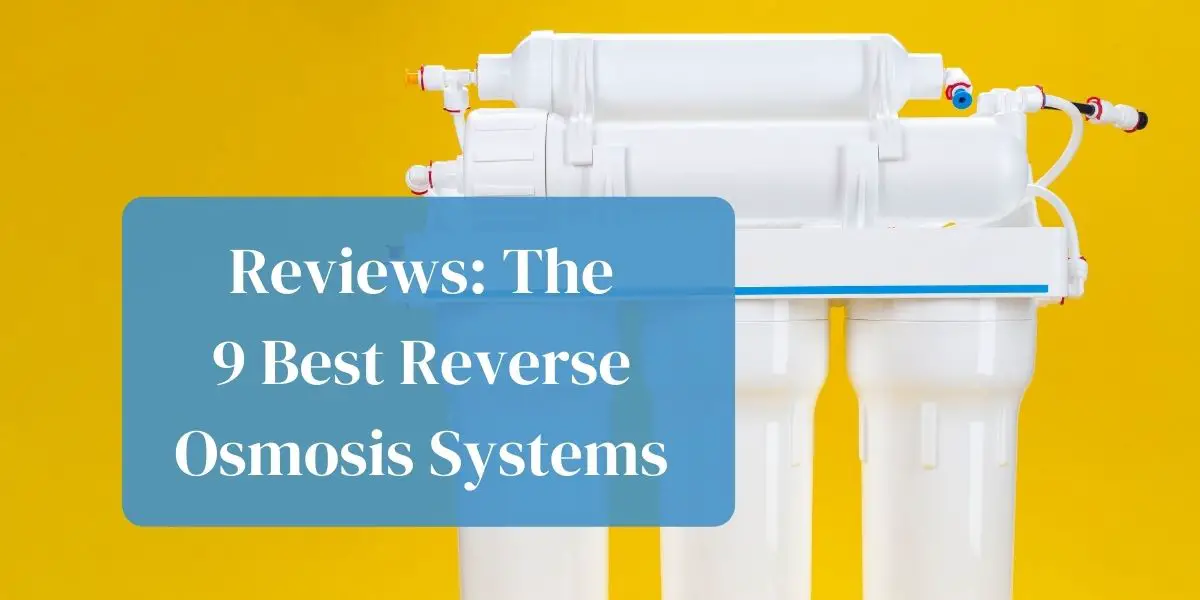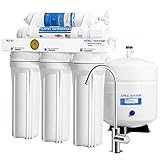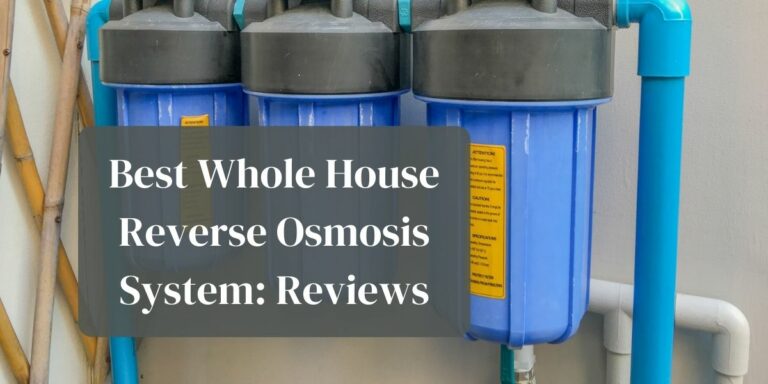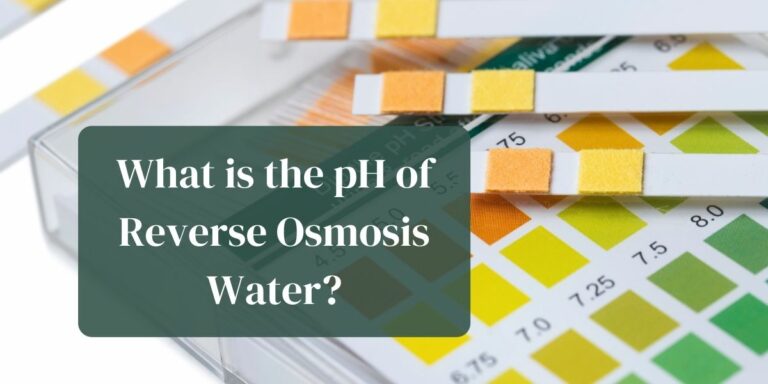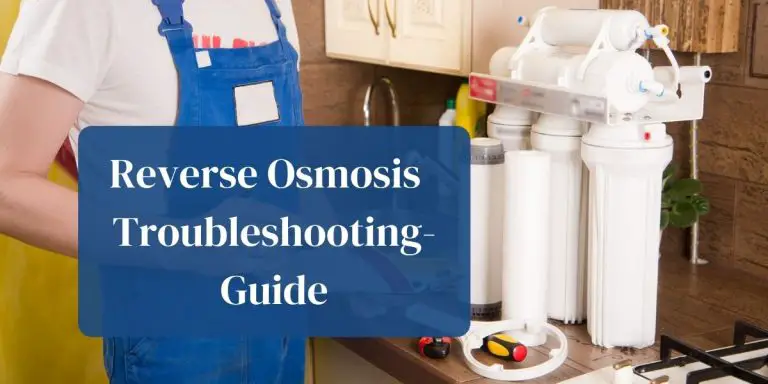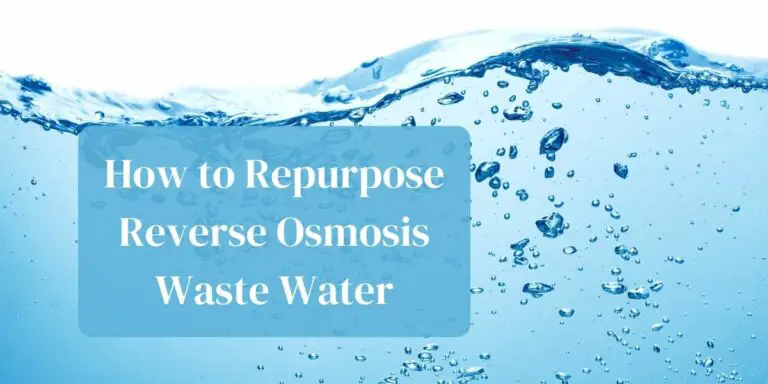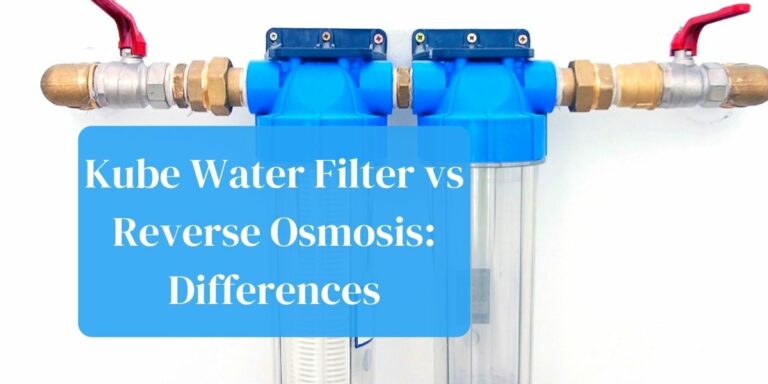With the environment constantly deteriorating, the integrity of the tap water in our homes has become compromised. A good solution to this problem is?reverse osmosis.
You are here because you know tap water is not the best water for your family, and you’re looking for a reverse osmosis system to solve that problem for you.
We feel that the best reverse osmosis system out there is the APEC Top Tier ROES-50. We’ve also reviewed more systems for you to consider.
Certain minerals and chemicals (like excessive amounts of chlorine) that are added to the water could pose a harm to your body.
The lead that coats the water pipes is another concern and prolonged use of water that is contaminated with these pollutants can be detrimental to your health.
That is why you need to make sure that you cement your safety by choosing one of these reverse osmosis systems and this website should point you in the right direction.
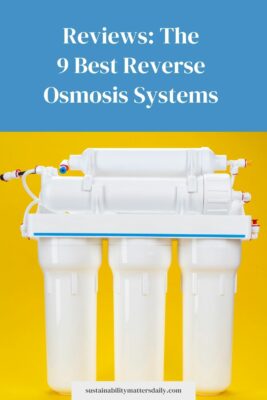
Table of Contents
- Introduction to reverse osmosis
- Best Reverse Osmosis System For Your Home: 9 picks
- Health Benefits of RO Water
- What is Reverse Osmosis?
- Reverse Osmosis Membrane
- Reverse Osmosis System Stages
- Accessories for RO systems
- Top RO System Brands
- Applications
- Reverse Osmosis System Terminology & Definitions
- FAQs
- Conclusion
Introduction to reverse osmosis
Reverse osmosis has been embraced by the world as a safe and affordable way to purify drinking water. It is effective in getting rid of dissolved chemicals and heavy metals such as: nitrates, sodium, crypto sporidium, fluoride, sulfides, giardia, arsenic, mercury, uranium, radium and lead.
Reverse osmosis process is also effective in getting rid of harmful bacteria and chlorine from water as it passes through the thin semi-permeable membranes.
RO is energy efficient as it doesn’t require use of electricity. All it requires is sufficient water pressure to power it through the entire process.
It’s an excellent way to filtern your whole house or just to a single tap.
Reverse osmosis continues to be one of the surest way to purify clean water for you and your family. It’s also quite reasonable cost-wise.
Best Reverse Osmosis System For Your Home: 9 picks
1. APEC Top Tier ROES-50 reverse osmosis (RO) system
- Supreme quality - designed, engineered, and assembled in USA to guarantee water safety & your health.
- Only technology to remove up to 99% of impurities including arsenic, chlorine, lead, fluoride, heavy metals, and 1000+ impurities. Max Total Dissolved Solids - 2000 ppm. Feed Water Pressure 40-85 psi
- WQA Certified System. Premium long-lasting filters used to treat tap water, well water. Provide unlimited clean, refreshing crisp tasting water superior to bottled water
- America's No.1 rated water filter brand with 20 years of success guaranteeing trouble free, noise-free system for long lasting, dependable, pure drinking water.
- System comes with 100% lead-free designer faucet, plus Certified JG premium grade tubing and parts to provide safe, impurity-free pure water. Pipe Size:1/4 inches
APEC Top Tier ROES-50 guarantees quality and safe water through a variety of features. These include a technology that is able to remove up to 99% of contaminants that include chlorine and arsenic as well as a wide variety of bacteria, viruses, metals and thousands of other contaminants.
The ROES-50 comes with a WQA certification that means that the system is trouble free and noise free. The long-lasting filters are able to treat both tap and well water providing crisp tasting and very refreshing water that is without a doubt superior to bottled water.
The Top Tier ROES-50 comes with a 1 year satisfaction guarantee and a lifetime support. The JG fittings that are quick to assemble and do not need any extra lock clips or leak sealing which allows you to start enjoying the benefits as soon as you make the purchase. It also comes with a 100% lead free chrome faucet and is certified by the FDA and NSF.
2. iSpring RCC7 Reverse Osmosis System
- [Effectively Remove Contaminants] This iSpring RO system is designed to produce great-tasting water that is clean, pure, and healthy for drinking. It uses a 5-stage filtration process that removes up to 99% of over 1,000 harmful contaminants, including PFAS, chlorine, fluoride, lead (removes up to 98%), arsenic, asbestos, calcium, sodium, and more. The under sink water filter system also reduces the TDS rate by 80% to 90% or better, making it ideal for drinking. Additionally, it removes hard water minerals like calcium, and magnesium that leave white residue or scale.
- [Certified to NSF/ANSI 58] The iSpring reverse osmosis water filters are designed in the United States and produced in strict accordance with American quality standards. Certified to NSF/ANSI 58 and has been dedicated to providing unlimited clean, refreshing, and crisp-tasting water superior to bottled water for American families for more than 15 years.
- [Low Maintenance and Leak-free Design] Quality components ensure reliability and low maintenance for many years to come. Clear see-through 1st stage housing makes filter inspection a snap. The system is compact and can fit under most kitchen sinks. It doesn't require any power source and comes with a check valve to prevent the backflow of water into the membrane housing, ensuring safety and avoiding water leakage. With a tank, it can meet the needs of big families or offices. The first filter housing is made of AS material (impact strength), allowing you to see the condition of the filter element without removing the casing and ensuring you always enjoy the best quality of water.
- [High Quality Design and Great Taste] The high-quality iSpring reverse osmosis system under sink helps you experience clean, safe, and good-tasting water every time you turn on the faucet. The system comes with a 100% lead-free designer faucet and certified food-grade tubing, allowing you to enjoy crystal clear ice cubes, fresher tea and coffee, better-tasting foods, and healthier baby formula. The reverse osmosis water system removes contaminants down to 0.0001 microns, and the fine GAC filter provides final polishing to the purified water.
- [100% Satisfied Customers] RCC7 from America’s favorite brand of under sink water filter is the highly rated reverse osmosis system. Comes with 1-year limited manufacturer warranty upon registration and lifetime personalized support from GA, USA, combined with premium quality components, this water filter is to deliver endless bottled quality drinking water right in your home for many years to come, eliminating plastic waste.
If you are looking for a water filter system with a manufacturer name that you can trust then the iSpring RCC7 could be the solution that you seek. It comes with a larger RO membrane that is able to deliver up to 75 gallons per day.
To make assembly easier, there is a DIY YouTube video available. To wipe off any worries that one might have about the quality of the iSpring RCC7, there is a 30 day money back guarantee to ensure that you invest in an RO system that is going to give you value for your money.
There is also a 1 year satisfaction guarantee and a lifetime support for the system from the company?s plant in Atlanta. The best part is that there is a number of upgrade parts and accessories that include a water detector, and EU style faucet, an auto shut-off valve and a Feed water adapter. Even though these are available at an extra cost they do come in handy and make the system more effective.
3. APEC Top Tier RO-90 RO System
- Enjoy unlimited ultra-fresh, clean, great tasting water right at home. Save money, time and hassle of buying costly, bottled water
- Designed, engineered and assembled in USA, RO-90 is a dependable RO System rated to last over a decade and will greatly improve your water quality
- Tested and approved by WQA to remove up to nearly all impurities including arsenic, chlorine, lead, fluoride, heavy metals and 1000+ impurities in your water
- Large super capacity filters deliver 2X impurity removing capacity for fewer filter change outs compared to smaller all-in-one filters that clog up quickly
- Comes with 100% lead-free designer faucet, plus JG high grade tubing to provide safe, impurity-free pure water. The original, top-notch JG Quick Connect fittings for easy and secure leak-seal. Maximum feed water pressure (psi):85
The APEC Top Tier RO-90 comes very near the top of a showdown of the top reverse osmosis systems on the market, with a variety of features that ensure that you not only get clean but also high quality water that has more value. It features the highest grade 5- stage ultra-pure system and NSF certified filters that ensure that you get water that is safe for you and your health.
It is a top tier build of the US brand and as such you get nothing less than the crisp tasting water that is superior to what you would be able to get from bottled water.
With an ability to remove up to 99% of the contaminants that range from arsenic to bacteria and heavy metals to ensure your safety, the APEC RO-90 comes with WQA Gold seal certification to allow for the best filtration efficiency. The faucets are 100% Lead Free and come complete with FDA and NSF certification ensuring that they are completely safe and of the best quality.
The filters on the RO-90 are super capacity and hence are able to service the user for twice as long. As if that is not enough, the filter comes with a 1 year satisfaction and a lifetime support.
The JG connect fitting require little effort to put together ensuring that the user enjoys simplicity and efficiency from the get go.
4. Home Master TMAFC Artesian System
- A better RO system | Home Master Artesian Full Contact’s innovative design solves most common problems associated with canister and tankless RO systems
- Mineral Water on Tap | Patented remineralization system adds calcium and magnesium twice during the purification process for reduced storage tank degradation and great tasting, highly pure Mineral Water on Tap
- NSF Certified Components meets or exceeds NSF standards for material safety and performance. NSF listed company. Made in USA
- Faster Flow Rate Included Fast Flo RO Kit has larger fittings and tubing provide twice the flow of traditional RO systems
- Modular design Easy to upgrade and service. Filter changes once per year or 2000 gallons with no wrenches required
If you have dealt with traditional RO (Reverse Osmosis) filters before then you know that they can be a pain. The slow water flow and unbearable inefficiency especially when the water pressure is low can be quite frustrating.
The Home Master TMAFC Artesian is designed to solve most of the problems that the traditional systems are not able to conquer. It comes with a 7 stage filtration system for nothing but the best results.
Aside from the filtration, it also has a mechanism to add minerals to give the water more value to the body and improved taste. The patented full contact technology allows the Artesian to add calcium and magnesium minerals two times during the process of purification. This in addition to its 98% purification rate, allows it get rid of a wide range of chemicals that include chloramine and a variety of other contaminants like bacteria and metals ensures that it is able to produce quality water.
Other beneficial features offered by the Home Master TMAFC Artesian include the long lasting and easy change filters that do not require any tools.
The filters need a change once a year or once every 2000 gallons. The filtration system offers water flow that is twice as fast compared to the conventional filters. This means that you not only get better quality water but you also spend less time filling your glass.
5. Home Master TMHP HydroPerfection reverse osmosis (RO) System
- A Better RO System | Home Master HydroPerfection realizes three major performance improvements - significantly reduced TDS Creep, 4.5 second fill rate, and significantly reduced water waste.
- EPA Registered | The Home Master is registered under EPA #97952-AZ-1 and has been approved to kill, inactivate or suppress growth of viruses, bacteria, fungi in water purification devices
- Mineral Water on Tap | Patented remineralization system found in our Artesian Full Contact model adds calcium and magnesium twice during the purification process for reduced storage tank degradation and great tasting, highly pure, Mineral Water on Tap
- Highly Pure Water | 9-stages of filtration, purification, UV sterilization and enhancement remove up to 99% of Chlorine & chloramines, chemicals, lead,heavy metals, fluoride, microplastics, TDS and thousands more. BPA and Lead free. 5 Year Limited Warranty
- Reduced Water Waste & TDS Creep | Built-in non-electric permeate pump reduces TDS creep and water waste up to 80%, increases water production up to 50%, for about a 1:1 waste ratio.
Home Master TMHP HydroPerfection filter system features a one of a kind filter design that seeks to address the issue that comes with most of the traditional models which is the replacement of filter canisters. Because of their build, such systems only allow the change of the filters.
However, the canisters which also collect residue overtime are not changed and as a result, you have a less efficient filtration system. This is a thing of the past with this particular model from Home Master.
To ensure the safest and the cleanest drinking water possible, the system comes with a whopping nine stages of filtration, purification and sterilization to ensure that you get nothing but the best quality water possible. Some of the materials that are used in the filtration process include sediment and catalytic carbon to ensure nothing big or small passes through the rigorous system.
Users will also get to experience the power of UV light when it comes to water filtration in the new cutting edge technology. The water enters a UV light sterilization chamber where it is bombarded with an intense light wave which eliminates the microorganisms and viruses in the water that might cause illness. This has been found to be more effective and safer compared to the use of chlorine.
If you are looking for a great water filter system that is able to cater to the modern needs in a modern and technology savvy manner, then the Home Master TMHP Hydroperfection Undersink RO system is definitely the perfect fit for you.
6. Express Water 5 Stage Home Drinking Reverse Osmosis System
- Reverse Osmosis Water Filter: Experience what water should taste like with the Express Water reverse osmosis water filtration system reducing up to 99.99% of Lead, Chlorine, Fluoride, Nitrates, Calcium, Arsenic, and more.
- Water Purification System: Drink the healthiest water on Earth. All our water filters are specially engineered to work together, producing the safest and best tasting water you’ll ever drink
- Under Sink Water Filter: Don’t waste money on professional installation. Express Water’s quick and easy-to-understand design means you can install and understand everything about your new water filtration system
- Under Sink Water Filter System: No need to mess with refilling or activating your water filter, Express Water’s water filtration systems automatically fill your water tank with high quality drinking water
- Leak Detection: Each under sink water filter includes an emergency leak stop detector that shuts off water flow when it detects unwelcomed moisture
Five stage designs for drinking water filter systems have a definite popularity, they’re simply what?s required to get the junk out of your tap water.
This reverse osmosis system is no exception, and the astute consumer will notice quickly that this one even comes with an extra set of filters so you can easily replace them down the line.
One of the best features of this filter system is the interchangeability of parts. Each part has been designed to meet the standards set in the water purification industry and fitting filters and parts should be able to easily be found in any big box store.
The level of convenience added by this is enormous, you won’t have to wait for the manufacturer to ship you parts or spare filters.
This is one of the most efficient models on the market, the manufacturer?s claim that it only uses two gallons of water for each gallon of purified water this water filter produces.
This means savings, and if you live in a drought-stricken area it remains an eco-friendly option. Like most of the systems, you can collect the ?waste? water and use it for purposes where the extra salts and contaminants will do no harm.
This fantastic offering from Express Water is geared towards convenience. The engineers obviously took into account the fact that most people who work on their home reverse osmosis (RO) systems aren?t plumbers and it’s both easy to install and work on.
Some people dread the task of having to replace their filters once or twice a year, but you won’t have to with this quick and easy system.
For those who want some convenience with their home filtration system, this bargain-priced offering from Express Water might be just the thing you?re looking for. The ease of use and solid filtration system will make for a fantastic consumer experience.
7. Brondell Reverse Osmosis System, WQA Gold Seal Certified
- WATER SAVING SMART TECHNOLOGY: This patented technology eliminates back pressure to make the Circle up to 10 times more efficient than traditional RO systems, saving water and money. In addition, Brondell Circle’s 6L tank refills fully in under one hour.
- COMPACT DESIGN: The reservoir and water filters are contained in a sleek case taking up less space under your sink. The twist and seal filters in this non-electric design make filter replacement a breeze. No pumps or electricity required!
- DESIGNER FAUCET: This elegant, chrome kitchen faucet is the embodiment of quality and efficiency. The integrated LED filter change indicator conveniently reminds you when to replace your filters.
- FOUR-STAGE FILTRATION: The Circle reverse osmosis water filter system utilizes 4 separate advanced water filters, dramatically reducing industrial and harmful chemicals. The patented Smart Valve & flexible water tank delivers maximum water efficiency
- WATER QUALITY ASSOCIATION CERTIFICATION: Our water filtration systems are tested & certified by the WQA, ensuring that you can trust in performance claims; The Circle meets NSF/ANSI standards 42, 53, 58, & 372; Certified for PFAS reduction, PFOA, PFOS
This offering from Brondell is super high-quality, and with that, unfortunately, comes a much higher price tag than a lot of offerings on this list. What does this mean for you as a consumer? Double the price.
All isn?t lost here, though because the upgrade over the functionality of normal reverse osmosis systems is pretty impressive.
The first thing that most consumers will notice is that this water filter takes up a fraction of the under-counter space that many of the cheaper offerings do. The RO water filter system is attractive and compact, all of the filtration contained within a single box-like device which won’t leave you trying to find a new place for your cleaning supplies.
The faucet has an LED system which will automatically change colors when you need to replace the filters. No more guess-work or using an expensive meter, this unit will tell you exactly when you need to switch things out in order to maintain the amazing water quality provided by the four-stage filtration system.
The unique design here leads us to a water filter which is easy to install and maintain, requiring virtually no plumbing skills. You also won’t have to be an amateur electrician to install it, it’s as close to plug-and-play as you?re likely to get with a home RO system.
This one?s also remarkably efficient with water usage, with a ratio of 2.1 gallons of water used for each gallon of usable, purified water produced. This saves money and also makes the Brondell H2O+ a good, green option.
If you have the money to spare, this RO filter system comes highly recommended. The ease of use and compact size more than makeup for the higher price tag and makes the H2O+ system one of the best options around for your home.
8. iSpring RCC7AK 75GPD 6-Stage Reverse Osmosis System
- Certified to NSF/ANSI 58, 6-Stage Alkaline Remineralization Layered Filtration - Exclusively designed to restore the natural alkalinity and mineral balance of water; this reliable and ultra-safe Reverse Osmosis (RO) water filtration system converts your water into clean, pure and healthy drinking water by removing up to 99% of over 1,000 harmful contaminants like PFAS (includes PFOA and PFOS), chlorine, fluoride, lead (removes up to 98%), arsenic, asbestos, calcium, sodium and more.
- GREAT-TASTING MINERAL WATER - A standard 5 stage RO system produces slightly acidic water with a pH of 7. 0 or below because the RO membrane removes not only harmful pollutants but also a few helpful minerals. The iSpring RCC7AK Reverse Osmosis water filter includes an additional 6th stage - an Alkaline Remineralization filter which restores healthy minerals and produces a balanced alkalinity, which gives your water a more natural taste than regular 5 stage RO water filter.
- LOW MAINTENANCE - Transparent 1st stage housing for easy visual inspection. Three extra long life pre-filters to remove large contaminants and protect RO membrane. Ultra fine (RO) filter to remove contaminants down to 0. 0001 microns; fine GAC filter to provide final polishing to the purified water and (AK) filter to finally restore just the right proportion of healthy minerals and a natural alkaline balance. The end result is great-tasting bottled-water quality.
- EASY TO INSTALL & NO LEAKS - The water purifier is designed for DIY installation and all necessary parts for installation are included. Backed by clear installation manual, instructional videos, and access to lifetime technical support. The entire alkaline system fits nicely under a kitchen sink. For leak-free installation, simply push tubing ½” deep into quick-fitting connectors and lock; no threading pipes needed. Note: Please ensure RCC7AK fits your under-sink area before purchasing.
- 100% SATISFIED CUSTOMERS - RCC7AK from America’s favorite brand of under sink water filter is the highly rated reverse osmosis systems. Comes with 1-year limited manufacturer warranty upon registration and lifetime personalized support from GA, USA, combined with premium quality components, this water filter is to deliver endless bottled quality drinking water right in your home for many years to come, eliminating plastic waste.
This is a great upgrade to the earlier iSpring offering in this list. This one offers six stage filtration and still comes in at a great price at just a bit over $200.
The sixth stage can make all the difference for those who are truly fanatical about their water quality, and more than justifies the small increase in the price point.
Of course, the low price does come with some disadvantages here. This is a complex water filter and can take some time to get set-up properly. If you completely lack plumbing skills it may be best to find something more convenient.
For those of us who can turn a pipe wrench and don’t mind playing with the pipes, though, the iSpring RCC7AK offers superior quality at a budget price.
Even better, this one can add back minerals to provide you with healthy and refreshing mineral water in addition to the normal purification from a reverse osmosis filter system. The total cost of this amazing feature? Roughly two cents per bottle of water. Imagine the savings you’ll be able to make!
If you?re looking for the best drinking water available for a low, low cost, you need to look no further. This RO filter system offers the best of both worlds, and the benefits of this reverse osmosis (RO) system can extend beyond mere convenience and into the realm of your health.
The only problem with this reverse osmosis setup is the fact that it may be a bit difficult to install. The instructions are easy enough, but if you don’t know anyone handy be sure to figure the price of installation by a certified plumber into your budget.
If you?re ready and willing to save some money on bottled water, this is the system for you. The addition of the minerals into the water during the last stage of filtration makes the iSpring RCC7AK an amazing option, and best of all it still comes at a bargain price.
9. Watts Premier RO-Pure 531411 4-Stage Reverse Osmosis System
- Four stage filtration: sediment pre-filter (WP105351) reduces dirt, silt; carbon pre-filter(WP105351) reduces chlorine taste and odors; the 50 GPD membrane (WP105331) reduces TDS, chromium, arsenic, copper, and lead; the carbon post-filter(WP105381) reduces chemicals like MTBE's, atrazine, benzene, and lindane
- The system includes a RO Pure Reverse Osmosis module with four pre-installed filters; a parts bag; a chrome, monitored, top-mount, air-gap faucet, and 3 gallon storage tank giving you crystal clear, high-quality, and great-tasting drinking water
- This space-saving, compact design allows this system to fit comfortably under your sink, requires fewer tube connections, includes back-flow prevention valves installed between the elements and cartridges have double O-rings so they won't leak
- The easy, quick-change push release filter system allows for easy filter change with no need to shut off the water source, is installed with check valves in the filter lid between cartridges to prevent back-flow and shut off valves in each filter head that shuts off the water flow when cartridges are removed
- Maximum operating pressure is 80 psi and to maintain top performance replace sediment and carbon pre-filters every 6 months, post carbon filter every 12 months, and the membrane every 2 to 5 years
Let’s take a look at things rationally, not everyone is going to desire an expensive unit with a bunch of extra stuff to make their water the absolute best. That’s where a product like this comes in handy. It’s a four-stage filtration unit that comes in at a bargain price.
The main draw of this unit is that it’s almost stupidly simple, anyone can easily install it and it’s fairly compact as well so you won’t have to sacrifice your under-the-counter to the nebulous gods of purified water.
For those on a budget, reverse osmosis systems often seem rather expensive, and this unit offers the basic functions of producing purified water without the complications. That said, it doesn’t offer all of the extras that a lot of the units here do, but if you just want to make dish spots a thing of the past for the lowest possible cost this is the best option.
Check out the best countertop reverse osmosis systems here.
Don’t be fooled, this reverse osmosis system still does pretty much everything you’ll need it to.
The simplicity lends itself to easy installation and use, and it comes with a chrome spigot which looks great. You might not receive added minerals or UV sterilization but it will definitely scrub out the chlorine taste and high calcium content of your water.
Some of us are tight on cash, but everyone deserves to be able to use purified water in their home. That’s where these budget water filter systems come in, and you can rest assured it’s high-quality. We wouldn?t recommend it otherwise.
If you?re on a tight budget but still desire the benefits of reverse osmosis filtration, we implore you to take a look at this budget under the coutner water filter. The cost is small and it has most of the benefits of the most expensive units.
Health Benefits of RO Water
Poor quality water has been linked to a wide range of physical health problems such as gastrointestinal, high blood pressure, immune deficiency and cancer.
Because of this more and more people today are looking for ways to ensure that their water is at a quality that will protect them and their family from any unwanted chemicals, metals, additives and dirt particles that can more readily get into water that is not filtered. But there is good news.
Today there are many more options to clean and filter water than ever before. One of the best ways to make sure that the quality in a home, business or office is of good quality is to purchase a reverse osmosis system for your budget and use, that still has a proven track record to reduce and remove harmful chemicals, metals, additives and dirt particles.
Check out the best whole house reverse osmosis systems here. You can also read about the best whole house water filters for well water.
In the past, older water filtration systems used a charcoal system that required filter replacement from the counter top every 100-200 gallons and reduced water contaminants in smaller amounts.
But today through advanced technological breakthroughs water filtration systems have a much longer life and provide a much higher filtration capability against contaminants.
Learn more: are reverse osmosis filters worth it?
Also worth reading: reverse osmosis vs distilled water
What is Reverse Osmosis?
Reverse osmosis (RO) is a water purification technology that employs the use of semi-permeable membrane to purify water. Reverse osmosis involves passing water through a semipermeable membrane which is small enough to allow water molecules to pass through as well as getting rid of larger molecules.
Reverse osmosis involves the use of applied water pressure to overcome osmotic pressure. This process can get rid of numerous types of ions and molecules from water such as bacteria.
Reverse osmosis is used in both industrial and residential production of water. During the production, the solute is usually retained on the pressurized side of the membrane while the pure solvent is on the other side of the membrane.
The membrane is designed in a way thus inhibits large molecules to pass through thus is able to separate clean and safe water from water with impurities.
The normal osmosis process involves the movement of water from an area of low solute concentration to an area of high solute concentration through a semi-permeable membrane.
The movement of pure solvent is triggered by the need to reduce the free system energy by balancing the concentration of solutes on the two sides of the membrane, thereby generating osmotic pressure.
Reverse osmosis can therefore be described as application of external energy to reverse the natural flow of a solvent. This reverse osmosis process is to an extent similar to other membrane technology applications.
However, reverse osmosis and filtration have some key differences. Filtration involves straining the solvent molecules as its predominant removal mechanism. This works by forcing the huge molecules to be unable to pass through the membrane regardless of the solvent concentration or pressure. However, reverse osmosis factors in diffusion as the process is water pressure and flow rate dependent. Most products on the market have to be certified by the NSF, an organization that vets many companies for public health and safety.
Reverse osmosis is well known for its use in the production of drinking water, where seawater is purified by removing salts as well as other effluent materials.
Reverse Osmosis Membrane
Membranes are some of the most important parts of reverse osmosis. Most of the membranes used in commercial reverse osmosis plants are made from cellulose acetate, polyamide and polysulfonate.
The membrane is usually made up of a 0.25 microns skin and a 100 microns of support layer. The skin is usually the barrier that allows only water molecules to pass through. Water purified through the reverse osmosis method usually has an amount of dissolved solids that is approximately a constant percentage of the dissolved minerals in feed water.
For instance, if the feed water has 400 ppm total dissolved solids (TDS), the product water may have 40 ppm or 20 ppm reflecting a 90% and 95% rejection ratio respectively.
A Reverse Osmosis system design is usually based on feed water TDS; the percentage or recovery and percentage of rejection desired. The higher the recovery percentage, the lower the refection percentage, the poorer the product water quality becomes.
Reverse Osmosis System Stages
Even though these machines are called “reverse osmosis systems”, the reverse osmosis is actually just a single stage in a multi-part filter.
Usually, there will be 2 to 3 filters, but this varies on the brand and the product.
There is an initial pre-filter which removes all large particles like sand, grit, and the like – these particles are large and abrasive and can easily damage the more sensitive RO filter.
Next, the water will pass through an RO filter, which does the main work of reverse osmosis and hence the name.
Finally, the water will pass through a post-filter – this is where any other dissolved gases and the like are removed.
You can tell how many filters an RO system has by the number of?stages the manufacturer states there are.
Accessories for RO systems
Even if you have a barebones RO system there are some accessories you can add for extra protection or enhancement of your water.
Remineralization
RO water is very close to neutral pH – this means there will be almost no dissolved minerals left. Some minerals may be beneficial, and others may slightly enhance the taste of the water. As a result, some folks like to add minerals back using a remineralization stage.
Beneficial minerals such as magnesium and calcium are added back to the RO water in limited quantities. Learn how to remineralize water after reverse osmosis.
UV Light
UV lights are a feature found in higher end RO systems but more manufacturers should really start using them. UV lights are relatively cheap so there’s no reason manufacturers should not be using them at all times.
While RO systems do manage to filter out a large bulk of microorganisms – and the added chlorine or chloramine from the municipal water supply does a fair job, too – if you want an extra safety step, UV light destroys up to 99% of all microorganisms.
This way you have completely bacteria-free water.
This may not be such an important feature if you’re using city water, but if you’re using well-water, it is almost a must have for extra protection.
Permeate pump
Permeate pumps are useful when the water pressure in your home is low. Since RO systems rely on water pressure to go against the osmotic pressure, low pressure means lower output and greater amounts of wasted water.
A permeate pump runs without electricity and simply circulates the water to generate more pressure. This also increases efficiency as less water will be wasted, and you’ll be able to filter water more quickly, too.
Top RO System Brands
We’ve reviewed a bunch of systems here and you may have noticed that some brands names keep popping up. Here’s some more information about these brands and why they’re so good at what they do.
Home Master
Home Master was originally known as Tap Master when they started manufacturing RO systems back in 2002. A unique feature of Home Master RO Systems is that they use modular filters, which are much easier to remove and replace, and since you don’t have to open anything to access the filter, no outside contaminants can get in.
Home Master systems have a technology they call “fast flow” which helps increase how much water the system outputs without having to make a bigger system. Some Home Master systems also have remineralization stages built in to them.
APEC Water
APEC Water has been in the RO system business for longer than Home Master – they’ve been around since the late 90s. They make their membranes and primary filters in the USA – many folks wish to buy Made In USA products over products made elsewhere.
APEC Water systems are very well known and it is not uncommon for them to top bestseller lists everywhere.
iSpring
iSpring is a small, family owned business that specializes in making under-the-sink RO systems.
Applications
Since the discovery of reverse osmosis, this system has become one of the world most useful technological breakthroughs. It has served a great purpose of provision of safe water for drinking at a cost effective price. This technology is not only used to purify drinking water, it is also used in many other areas. As I conclude, I want to take you through some of the areas where reverse osmosis has had great impact.
Drinking Water
Reverse osmosis is providing safe water for drinking in many households across the world. Corporations are turning to RO systems to quench their employees thirst while companies are bottling RO purified water. The U.S. military serves between 1000 and 6000 soldiers with RO water while NBC (Nuclear/Biological/Chemical agents) use RO water for their operations.
Waste Water
Collected rainwater is usually used as feed water in Reverse Osmosis Systems and used for industrial cooling and irrigation. Big power plants use RO to get rid of minerals from water used in boilers. This helps in using pure water in the boilers as it doesn’t leave deposits that corrode and damage the machinery. Singapore announced their intention of treating their waste water using RO system before re-introducing them back into the reservoirs.
Food Industry
Reverse osmosis is used in food factories to thicken food liquids like tomato and orange juice, which when processed with heat lose their nutritional values. RO is used in concentration of milk and whey protein powder production in dairy industry. RO is used to remove acetic acid, alcohol and smoke in wine industry. RO is used to get rid of excess water from maple sap. This system removes 80% of water thus reducing the boiling expenses of the syrup.
Car Wash
Car wash entrepreneurs use reverse osmosis machines to treat hard water. Hard water is known to cause spotting on vehicles. By treating it with reverse osmosis, the heavy minerals in this water are removed. This also leads to lower demands by customers to have their vehicles dried, thus cutting on costs.
Reef Aquariums
Reef aquarium keepers have realized that tap water has dissolved chlorine, heavy metals, chloramines, nitrogen compounds and phosphates which are not ideal for the artificial mix of sea water.
You have now seen the how important reverse osmosis is in our day to day lives. Reverse osmosis does not only produce drinking water but water for many other uses as evidenced above. Reverse osmosis is very ideal in our homes as it ensures that you will never expose your family to diseases resulting from use of contaminated water.
Learn about the best RODI systems for reef aquariums here.
Reverse Osmosis System Terminology & Definitions
RO System?terminology can be confusing at times, so if you?re stuck wondering what a certain term means, the following short list should give you a helping hand:
Reverse Osmosis Standards:
There are several organizations that check the standards of Reverse Osmosis systems and certify them according to their level of functionality. Manufacturers design and build their systems, according to these standards.
WQA Standards:
WQA is the source of information for water filtration industry to educate professionals and provide a testing lab for water filtration products. The products developer under WQA standards are certified and give an acknowledgement to public about the purity of water being used. The entire WQA certified reverse osmosis products are built on the following standard.
?NSF/ANSI 58 (02/29/2012): Reverse Osmosis Drinking Water Treatment Systems* is within WQA’s ANSI and SCC approved scope of accreditation?
NSF & FDA are public health and safety organizations and manufacturers design their products to conform with their standards.
This gives them? market advantage as well as a satisfaction of building standard products. Several components of Reverse Osmosis systems are NSF certified like filter pipe fittings and polythene tubing. Manufacturers use these products to assemble their reverse osmosis systems.
Ideally, the best reverse osmosis system will be one that is certified by the NSF and FDA.
JG or John Guest Fittings and Plumbing:
John Guest is the world known fittings and plumbing that provide standard fittings for Reverse Osmosis systems. They offer several fitting components like UV Light Replacement Parts, RO Faucets and Accessories, RO system installation accessories, Replacement Pumps etc.
VOCs:
VOCs are volatile organic compounds that contaminate water and may result into harmful effects on human health. These VOCs can be transferred to the human body when a person drinks the contaminated water. During reverse osmosis the osmotic membrane filters, micro-particles, including VOCs and ionic compounds to improve the quality of drinking water.
POU and POE systems
RO systems can be used in two different ways. It can be a POU or point of use system. Such a? system is fitted? right on the spot with the tap or water supply.
While the POE reverse osmosis systems work at the point of entry . It means such systems are placed where the main supply of water enters.
TFC and CTA membranes
TFC membranes are used in RO purification systems and are thin film composites used to purify water. Another type is CTA membranes or cellulose tri-acetate which is also used in these systems. Of these two, TFC is known to work much better as compared to the CTA membranes.
What is GAC?
Granular activated carbon filters are used as pre-filters in RO water purification systems that purifies the water? and facilitates further purification processes.
Cross flow system
A Cross flow system used in the RO water purification system provides a double flow of of water in which the water flows through the membrane and gets purified as well as some water flow downside to take the impurities to the drain of the storage tank.
It makes the water completely safe and purified as the impurities are constantly washed away during the filtration process.
FAQs
I’ve heard that RO Systems waste a lot of water. Is this true?
Unfortunately, this one is accurate to a certain extent. Since we’re talking about?filters, some water is indeed wasted – but the water that is wasted is incredibly concentrated with minerals and contaminants – to generate clean water, you have to discard some “dirty” water.
Most systems are quite efficient, though. If you search online or read news websites, they may say that 20 gallons of water are wasted for producing one gallon of RO water – this may be true for industrial systems, but a more realistic estimate for home systems is 3 to 4 gallons of wasted water for one gallon of purified water.
Are RO Systems easy to install?
Some RO systems sit on your countertop and are incredibly easy to install. Others that mount under your sink are a bit more involved but it’s nothing that you can’t manage if you’re willing to do a little DIY.
How often do I change the filter?
Depending on the quality of water, an RO filter can last anywhere between 1 to 3 years before needing a change. As the filter accumulates more and more debris, its efficiency will decrease.
The best way to check if your filter is still going strong is to use a TDS meter.
- Reliable Brand: MEXYBE was founded with a simple yet important mission: to provide everyone with a accurate and reliable way to test their water quality. We believe that access to clean and safe drinking water is a basic human right, and our turbidity meters tds meter digital water tester is one professional way that can help people achieve that. We are committed to providing high-quality products and excellent customer service. Join us in our mission to make clean accessible to everyone
- Accurate and Reliable Result: Are you tired of unreliable results from other turbidity meters water tester for drinking water? Look no further than MEXYBE 2024 ALL-NEW high precision chip and premium quality titanium alloy probe, designed to deliver accurate and reliable performance every time. With state-of-the-art technology and advanced features, our turbidity meters water quality tester is the ultimate choice for achieving precision in your testing. So why wait?
- Multifunctional Turbidity Meters and 5 Upgraded: Professional TDS (Total Dissolved Solids), EC (Electrical Conductivity), and TEMP (Centigrade, Fahrenheit) Meter in one turbidity meters. Upgraded with big backlit LCD for easier reading, auto-lock function for easier use, factory calibrated for direct use and auto-0ff in 2 minutes to conserve battery. These enhancements make it a user-friendly turbidity meters tds meter digital water tester for a variety of applications
- Two User-Friendly Design:1. Large backlit LCD screen 25% larger: the screen of the MEXYBE 2024 turbidity meters water quality tester has been enlarged by 25%, which makes it easy to read even for the elderly or children. 2. Add a colorful tds chart on the turbidity meters tds meter back and user guild: no need searching for an explanation of the TDS value, all you need to do is look at the back of the turbidity meters water tester or the user guild to get an explanation of the PPM
- Multipurpose Turbidity Meters: Test the purity and turbidity of drinking water to ensure it's safe and healthy, monitor if Reverse Osmosis (RO)/Deionization(DI) System works properly, whether filter need replaced, maintenance aquarium, hydroponics(test nutrients), pool and spa, etc.
A TDS meter measures “total dissolved solids” – you can simply compare the TDS of water before it goes into the system and TDS after it exits the system.
A properly functioning RO system will reduce the TDS from before by about 90%, though this varies from system to system.
If you’re not anywhere in that ballpark, you need to change your filter.
Conclusion
As you can see, there are multiple benefits to having reverse osmosis systems in your home. You can rest assured that you’re drinking and using safe, purified water. We hope that these reviews of the best reverse osmosis systems have been helpful in making a choice.

